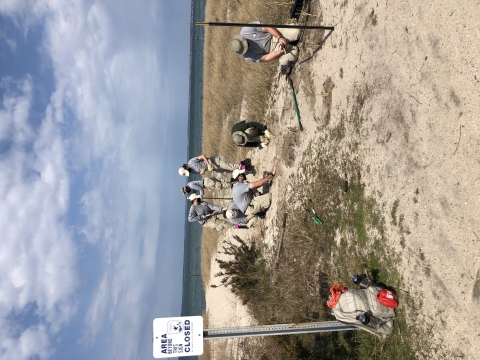What We Do
Beach Nesting Bird Monitoring
Seasonal interns are hired each year to assist with beach nesting bird monitoring (left image) during the spring and summer months. In addition to the piping plover enclosures, interns monitor bird locations and species numbers daily. This information is used to estimate regional numbers of these federally and state threatened and endangered species.
Invasive Species
Refuge staff are founding members of the Long Island Invasive Species Management Area. Networking with other members and attending periodic public meetings has helped us realize the most problematic species, develop mapping standards, prioritize treatment regimens and prepare outreach materials.
Unfortunately, much of the habitat adjacent to public-use areas, contain abundant invasive exotic plants such as garlic mustard, Asiatic bittersweet, Japanese honeysuckle, and Japanese barberry.
Trapping
Trapping is a wildlife management tool used on some national wildlife refuges. Trapping may be used to protect endangered and threatened species or migratory birds or to control certain wildlife populations. The U.S. Fish and Wildlife Service also views trapping as a legitimate recreational and economic activity when there are harvestable surpluses of fur-bearing mammals. Outside of Alaska, refuges that permit trapping as a recreational use may require trappers to obtain a refuge special use permit. Signs are posted on refuges where trapping occurs. Contact the refuge manager for specific regulations.
Dune Grass
Refuge staff and Americorps crew members planted dune grass to restore coastal habitat. This area was trampled by visitors, resulting in the loss of dune grass. To restore this area, refuge staff and the Americorps crew planted 360 plugs on about 1/10 of an acre and the area was fenced off to prevent trampling of the new plants. Visitors that witnessed the planting were supportive and pleased to see staff and Americorps restoring the area.
Mile-A-Minute Bio Control
Refuge staff and interns released weevils as a bio-control for the invasive mile-a-minute plant. Staff released weevils in varying quantities at four sites, including three quick release sites and one ten-quadrat transect. Prior to release, biologists surveyed invasive plants throughout the refuge and recorded using visual estimation of percent cover. At each release site, biologists performed a species inventory and initial assessment of mile-a-minute. Just four days after release, the weevils are making visible impact!
Management and Conservation
Management Goals
Refuge management goals are:
- Provide and manage a diversity of high quality habitats to support breeding, migrating and/or wintering birds, threatened & endangered species and fish.
- Maintain high quality habitats for all native wildlife and plant species.
- Establish and maintain partnerships to benefit wildlife for present and future generations.
Our Services
At this field station we offer a variety of public recreation opportunities, including fishing, hiking, wildlife observation, nature photography, interpretive programs and environmental education.
Our Projects and Research
Current Projects Include
Refuge staff and Americorps crew members planted dune grass to restore coastal habitat. This area was trampled by visitors, resulting in the loss of dune grass. To restore this area, refuge staff and the Americorps crew planted 360 plugs on about 1/10 of an acre and the area was fenced off to prevent trampling of the new plants. Visitors that witnessed the planting were supportive and pleased to see staff and Americorps restoring the area.
Mile-A-Minute Bio Control
Refuge staff and interns released weevils as a bio-control for the invasive mile-a-minute plant. Staff released weevils in varying quantities at four sites, including three quick release sites and one ten-quadrat transect. Prior to release, biologists surveyed invasive plants throughout the refuge and recorded using visual estimation of percent cover. At each release site, biologists performed a species inventory and initial assessment of mile-a-minute. Just four days after release, the weevils are making visible impact!
Law Enforcement
The mission of the National Wildlife Refuge System Law Enforcement program is:
"Through education and enforcement we protect our employees, volunteers, and visitors; safeguard the public’s investment in facilities and equipment; and protect the integrity of the habitat and the wildlife resources of the National trust resource which is the 150 million acre National Wildlife Refuge System.”
Laws and Regulations
To protect the natural resources of the refuge and to provide all visitors with a safe and enjoyable wildlife experience, please observe all refuge signs and regulations in handouts and brochures.




